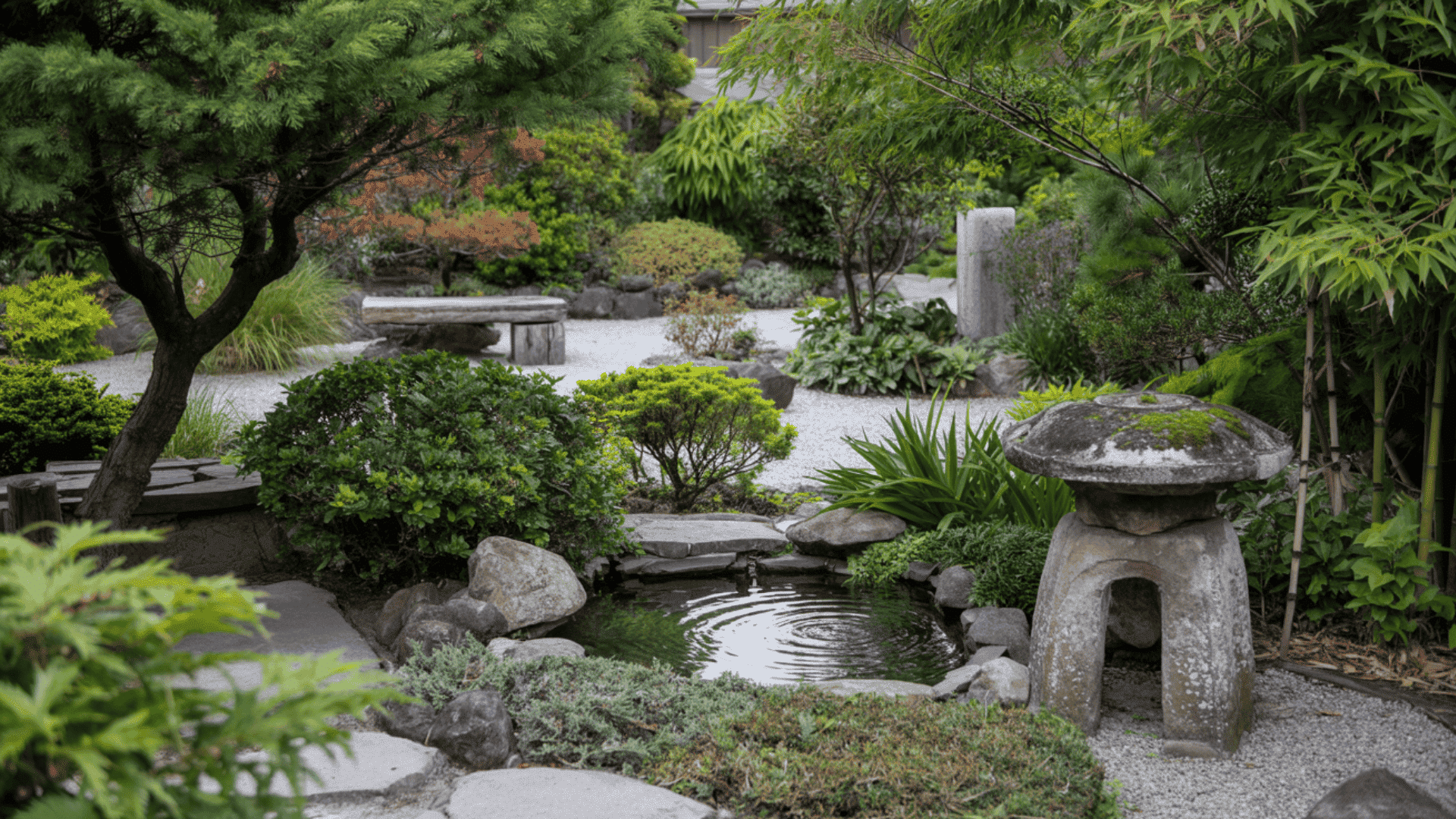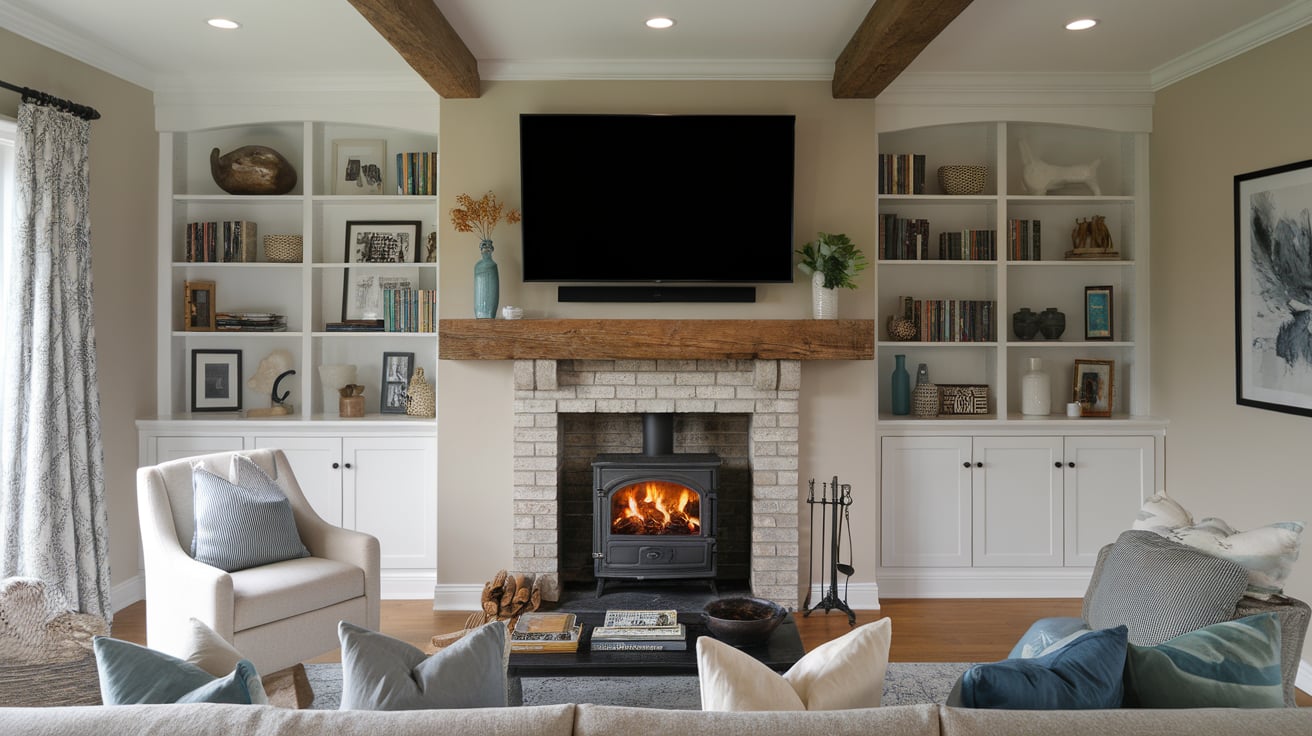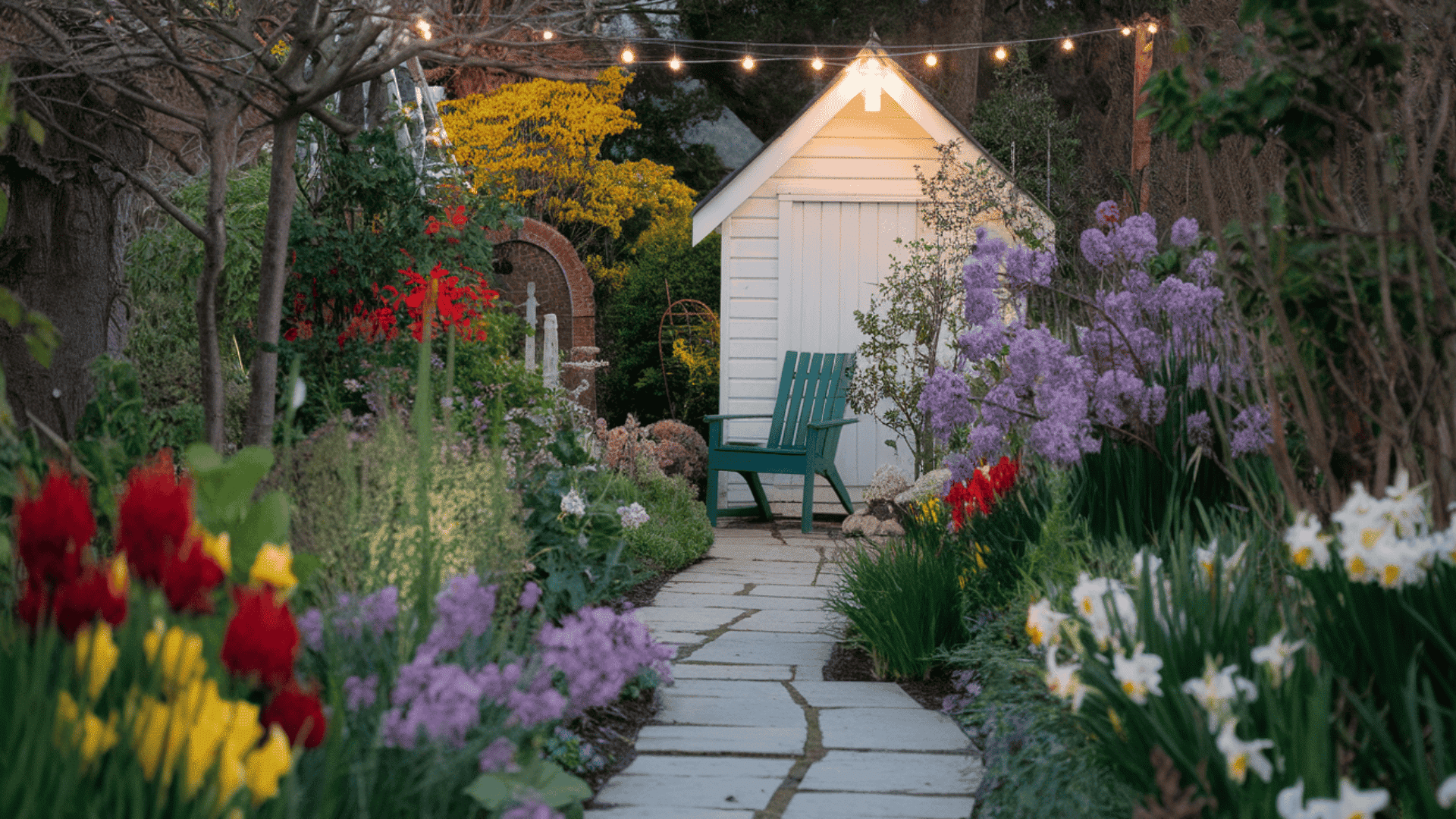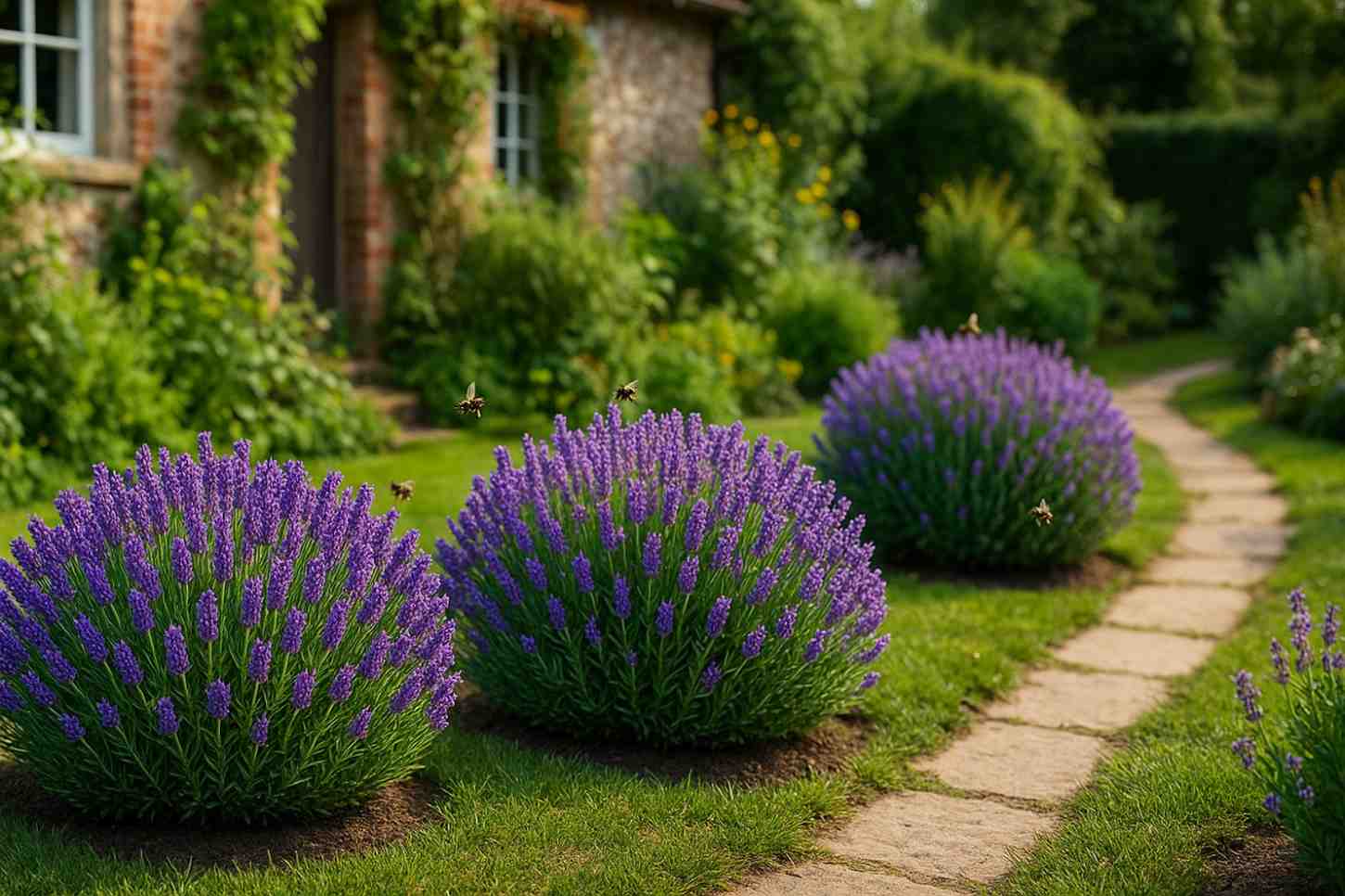Creating a peaceful outdoor space feels impossible when your yard looks chaotic and stressful. You want that calm, zen-like feeling every time you step outside, but don’t know where to start.
Most homeowners struggle to transform their cluttered backyards into the serene retreats they dream about.
Japanese gardens bring tranquility because they adhere to time-tested design principles that strike a balance between nature and human needs.
These timeless gardens succeed because they adhere to specific principles that foster harmony between nature and human needs.
You’ll learn the core principles that make these gardens so peaceful, learn which essential elements to include, and get practical layout strategies that work for real homes.
We’ll also get inspiration from authentic examples and show you how to adapt traditional concepts for modern living spaces without breaking your budget.
What is a Japanese Garden?
A Japanese garden is a carefully designed outdoor space that captures the essence of nature in a simplified, symbolic form. Japanese gardens are also known as Zen gardens.
Instead of recreating landscapes exactly, these gardens distill mountains, rivers, forests, and meadows into miniature expressions using stones, water, plants, and pathways.
Unlike decorative Western gardens that often emphasize color and abundance, they’re carefully planned spaces that reflect deeper philosophical ideas about nature and peace.
What makes these gardens special comes down to four key characteristics:
1. Connection to Nature: Every element mimics wild landscapes. A curved path becomes a mountain trail. Grouped stones represent distant peaks. Even tiny courtyards feel like forest clearings.
2. Seasonal Beauty: These gardens change throughout the year. Spring brings cherry blossoms. Summer offers cool water features. Fall displays red maples. Winter reveals the garden’s structure through bare branches.
3. Contemplative Spaces: Unlike Western gardens focused on flowers, Japanese gardens prioritize quiet reflection. They create natural spots for sitting and thinking. Water sounds replace traffic noise.
4. Symbolic Meaning: Every placement has a purpose. Three stones might represent Buddha and his disciples. Stone lanterns guide spirits. Raked gravel becomes an ocean. These symbols add depth without requiring knowledge to appreciate the beauty.
At their core, Japanese gardens give you more than just something pretty to look at. They become real spaces where you can think, relax, and feel at peace with the world around you.
Japanese Garden Design Principles
Creating your own Japanese garden means following five time-tested design principles that work together to create harmony and peace:
| Principle | Key Idea | How to Use It |
|---|---|---|
| Small Worlds, Big Stories | Turn tiny spaces into vast landscapes. A small pond becomes a lake, three rocks become mountains. | Let elements tell stories. A winding path reveals life’s twists and turns. A single tree represents hope. |
| Odd Numbers Over Symmetry | Skip perfect matching. Use uneven, natural placement instead. | Choose three stones, not two. Use five stepping stones, not four. Feel random, not arranged. |
| Empty Space Has Power | Blank areas matter as much as filled ones. They give the eyes rest and the mind peace. | Try raked gravel or simple grass. Less crowding makes remaining elements feel more important. |
| Love Imperfection | Weathered beats shiny. Moss-covered stones beat polished ones. Age adds beauty. | Let materials weather naturally. Keep the moss. Don’t replace everything that shows age. |
| Borrow Distant Views | Your garden extends beyond your fence. Include the neighbor’s trees and distant hills. | Frame views with your plants. Create gaps that showcase beautiful trees nearby. |
Essential Elements of a Japanese Garden
Every authentic Japanese garden contains certain key elements that work together to create the peaceful atmosphere.
You don’t need all of these elements, but including a few will give your space that distinctive Japanese feel:
1. Water Features That Soothe
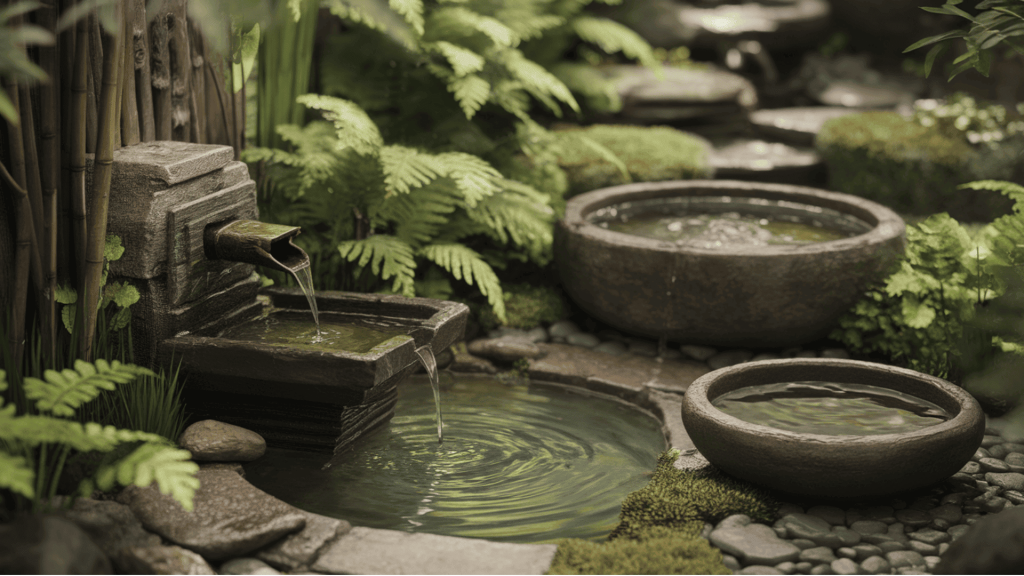
Water brings life and movement to your garden. The sound of flowing water masks street noise, creating a calming background. Even the smallest water feature can make a significant difference.
Simple options include:
- A small fountain with a bamboo spout
- A shallow basin that catches rainwater
- The stone bowl is filled weekly by hand
- Small pond with a quiet pump
Note: Even the simplest water element, like a stone bowl, can bring the same sense of peace as a larger fountain.
2. Stones That Ground the Space
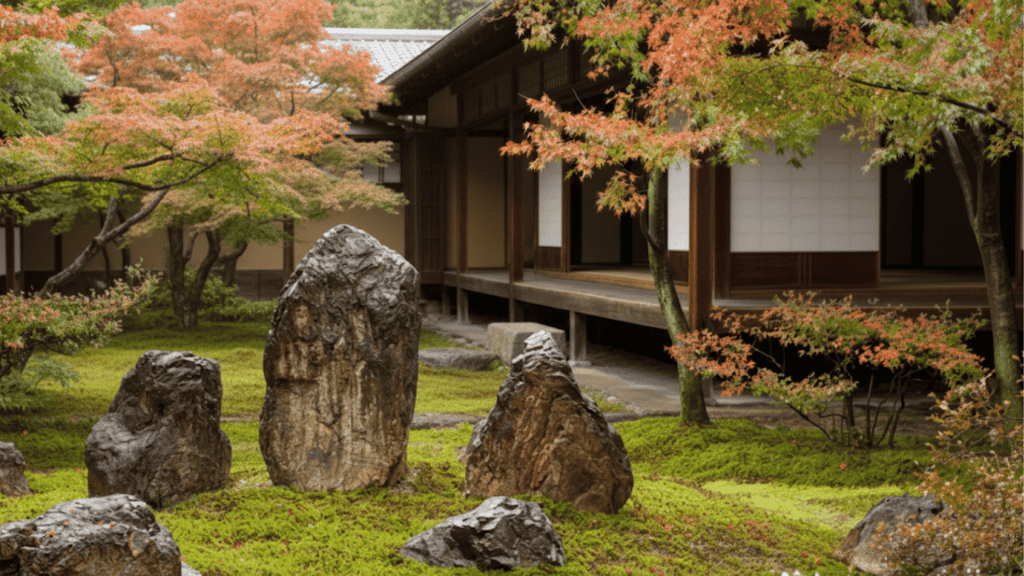
Rocks represent mountains and stability in Japanese gardens. They anchor your design and provide visual weight that balances softer plants. The right stones become the backbone of your entire garden.
Placement guidelines:
- Choose stones with interesting shapes and textures
- Place them in odd-numbered groups
- Bury them partially so they look natural
- Position larger stones first, then smaller ones
Note: Think like nature when placing stones. They should look like they’ve been there for years, not like someone just dropped them off.
3. Plants That Change With Seasons
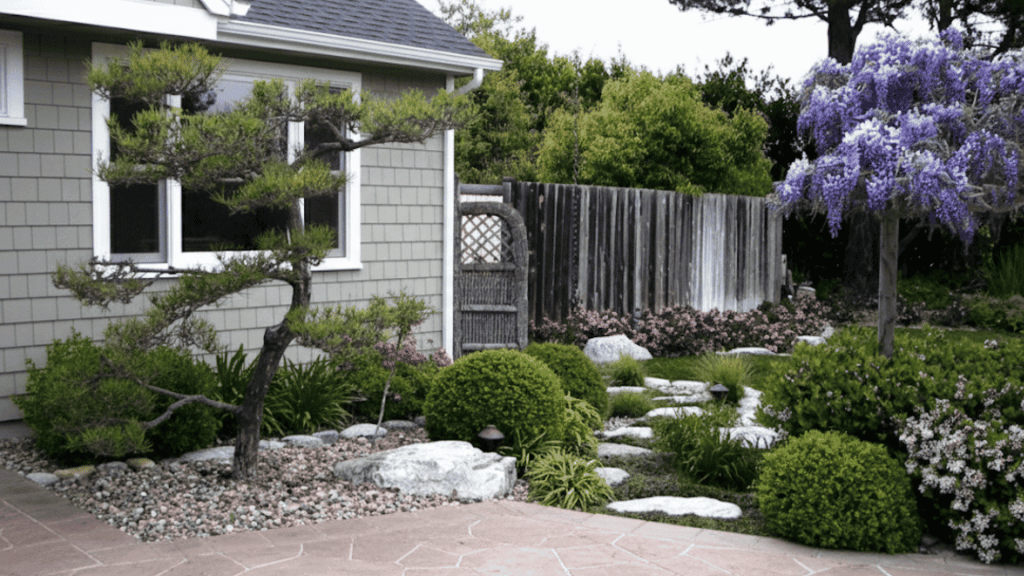
Japanese gardens rely on green plants more than colorful flowers. Choose plants for structure and subtle seasonal highlights rather than short bursts of color.
Key plant types:
- Evergreen shrubs for year-round structure
- Maple trees for brilliant fall color
- Bamboo for movement and gentle sound
- Moss for soft, natural ground cover
Note: Choose plants that look good in winter too. Your garden should have beauty in every season, not just spring and summer.
4. Pathways That Slow You Down
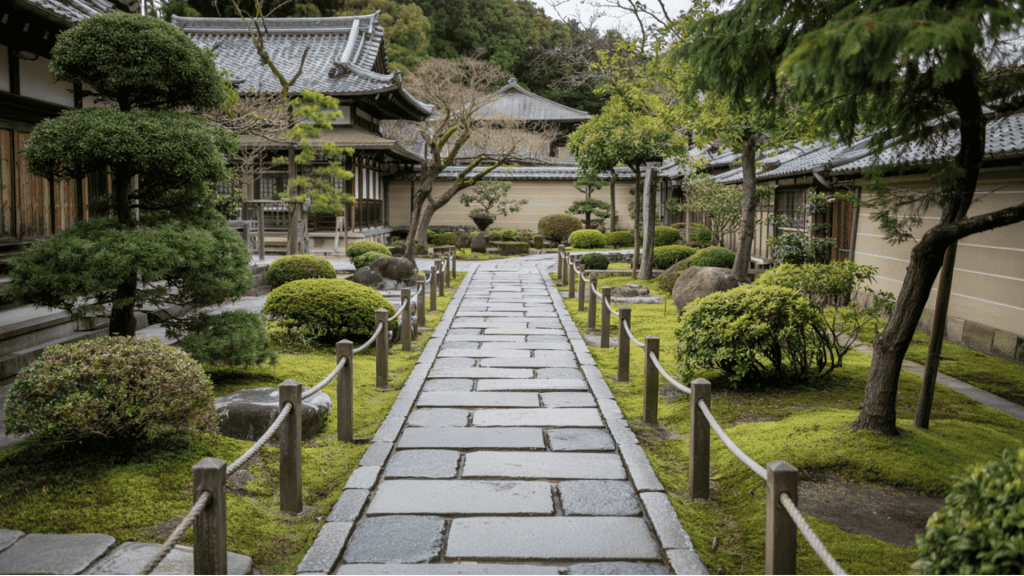
Winding paths force visitors to slow down and notice details. Use natural materials like stone, gravel, or wood stepping stones. The goal is contemplation, not efficiency.
Design approaches:
- Make paths curve around obstacles
- Use different materials for variety
- Leave gaps between stepping stones
- Create wider spots for pausing
Note: Never make paths perfectly straight. Curves create mystery and make even small gardens feel larger than they really are.
5. Lighting That Extends Evening Hours
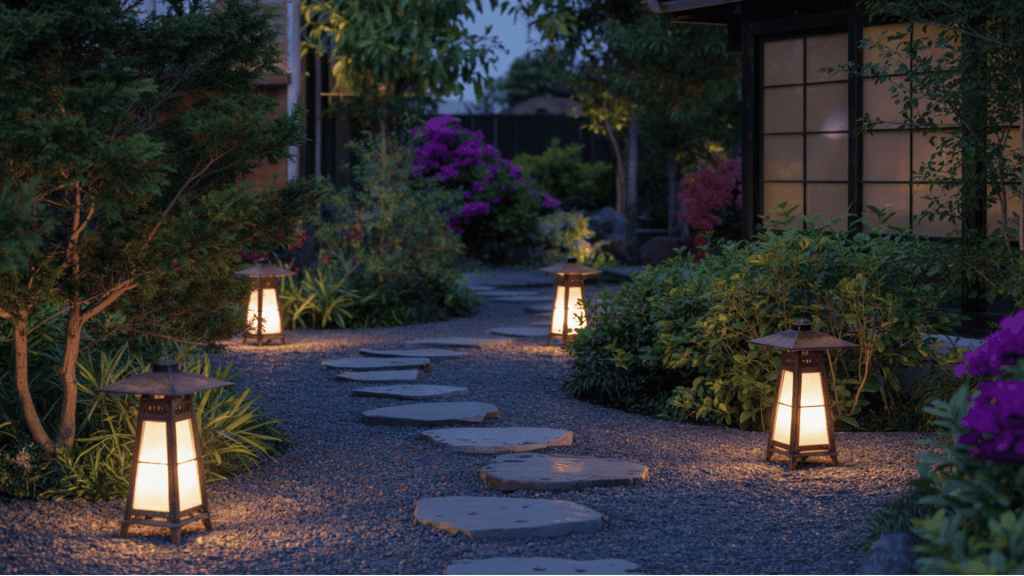
Stone lanterns traditionally lit the way for tea ceremonies. Today, they add charm during daylight and soft illumination after dark. Good lighting extends your garden’s usable hours.
Modern options:
- Solar-powered lanterns for easy installation
- LED candles for safe flickering light
- Small spotlights hidden in plantings
- Paper lanterns for special occasions
Note: Place lights along pathways and near seating areas. The goal is gentle guidance, not bright illumination that destroys the peaceful mood.
Planning and Layout Strategies for a Japanese Garden
Smart planning makes the difference between a garden that works and one that disappoints. Here are the key strategies that work for any size space:
- Start with your best views: Walk around your yard and identify where you’ll actually sit or look from windows. Design everything to look good from these spots.
- Work with existing features: Use slopes for cascading plants. Turn wet areas into water features. Frame new plantings around mature trees you already have.
- Create gentle transitions: Transitions should feel natural, with paths and plantings guiding you gently from one area to another.
- Plan for year-round interest: Choose elements that look good in winter, too. Structure matters more than seasonal flowers.
- Keep maintenance access in mind: Leave space to reach plants for pruning and cleaning. Beautiful gardens require regular care to maintain their beauty.
Japanese Garden Design Ideas
Examining various Japanese garden ideas helps you understand how these principles are applied in practice. Here are some inspiring approaches that showcase different design ideas:
1. Small Courtyard Zen Garden
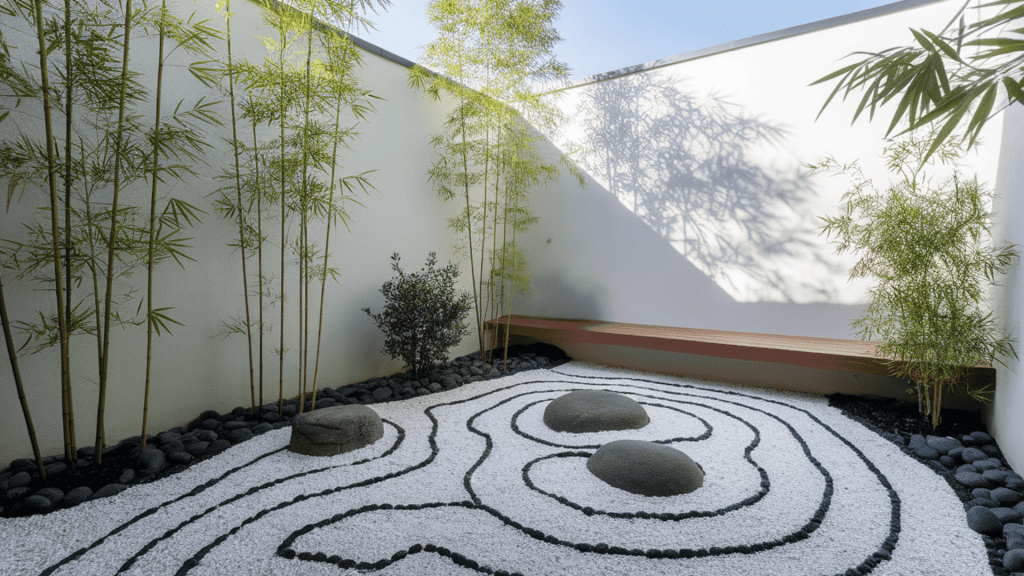
A tiny space with three large stones, white gravel, and a single bamboo plant. Perfect for apartments or small backyards where simplicity creates maximum impact.
2. Backyard Tea Garden
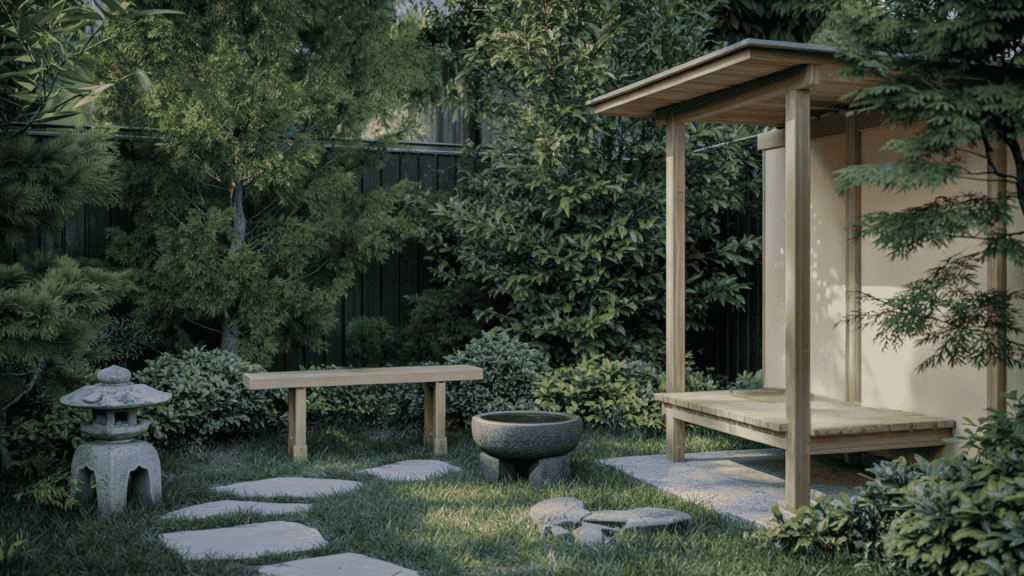
Winding stone path leads to a simple wooden bench surrounded by evergreen shrubs. A small water basin and stone lantern complete the peaceful retreat feeling.
3. Modern Minimalist Garden
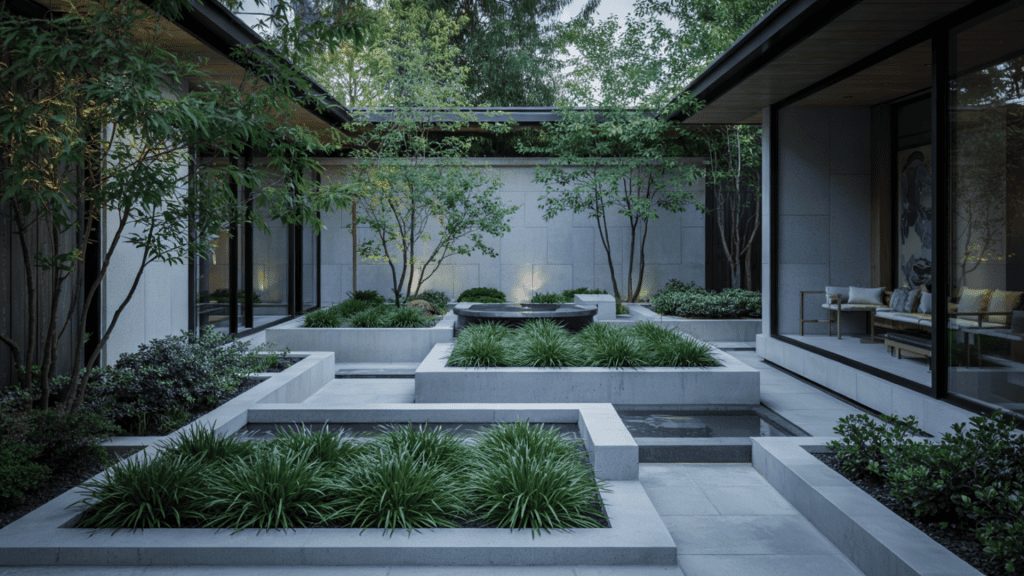
Clean lines with concrete planters, ornamental grass, and a single water feature. Demonstrates how traditional Japanese principles can be applied to contemporary home designs.
4. Hillside Cascade Garden
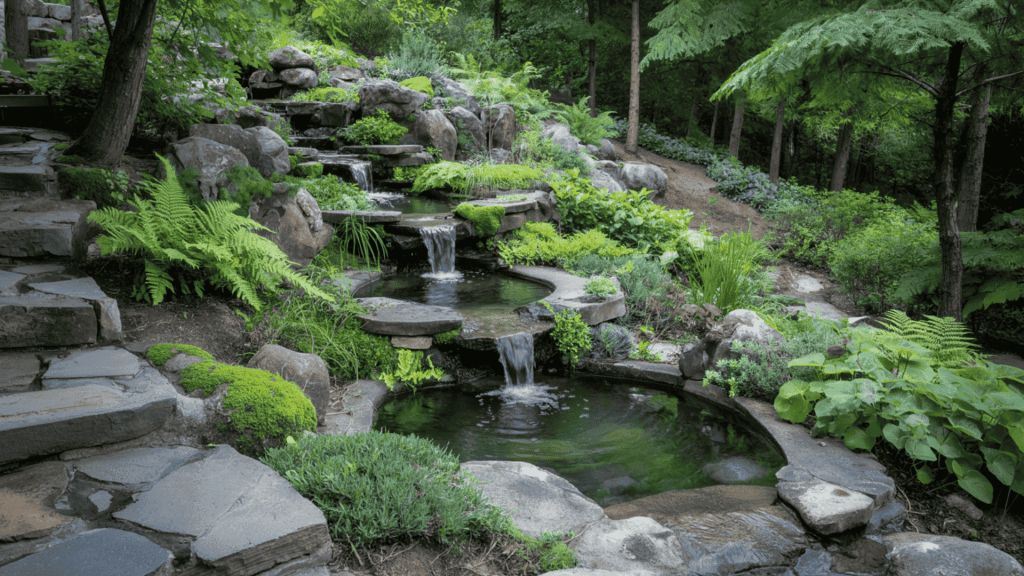
Natural slope becomes a series of small pools connected by gentle waterfalls. Moss-covered rocks and ferns create a forest-like atmosphere even in suburban settings.
5. Container Japanese Garden
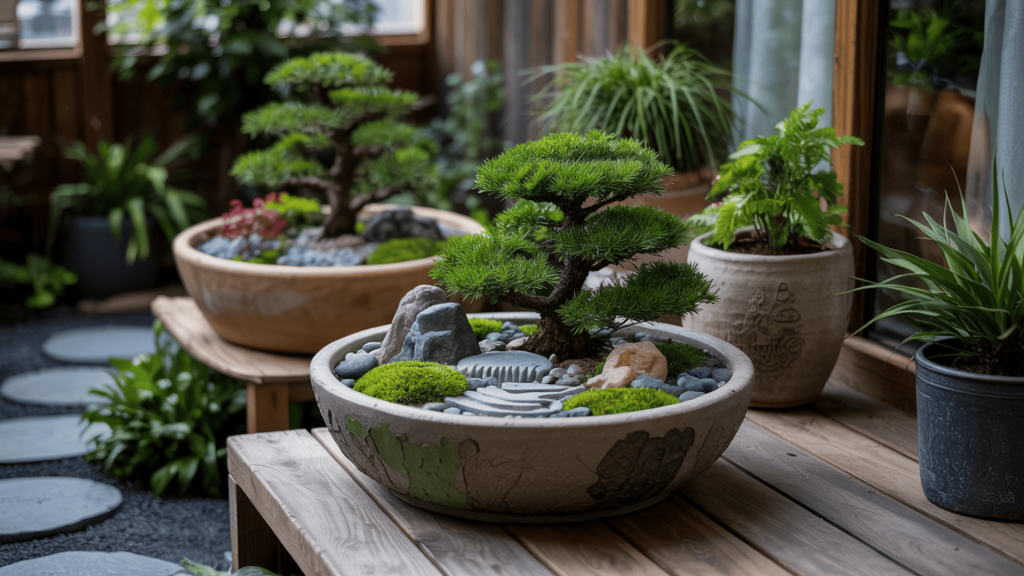
Large pottery bowls hold miniature landscapes with tiny trees and pebbles. Bring Japanese garden principles to patios, decks, and indoor spaces.
Final Thoughts
Your Japanese garden design is really about choosing what matters most, not cramming in every possible feature.
One stone lantern or the gentle sound of water can completely change how your outdoor space feels.
Don’t pressure yourself to finish everything at once. Let your garden grow naturally over time. The real magic happens when you stop rushing and start enjoying the process itself.
It matters because in our busy world, having a peaceful retreat steps away from your back door isn’t just nice, it’s necessary for your mental health and daily happiness.
Pick just one element that excites you most.
Maybe it’s three interesting stones, or a simple ceramic bowl that catches rainwater.
What’s calling you first? Share your starting point with us below!
